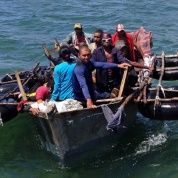The Cuban Adjustment Act, passed in 1966 by the U.S. Congress, allowed any Cuban who entered the United States to gain permanent residency after being present in the U.S. for one year. This law, passed at the height of the Cold War, is unique to Cuban emigrants, with no other migrant group given this special consideration.

It was passed in order to encourage emigration from Cuba to the United States. After the triumph of the Cuban Revolution, there was an exodus of Cubans opposed to the revolution who fled to the United States. In his autobiography, Fidel Castro stated that in the first three years after the revolution, more than 270,000 Cubans migrated to the United States.
Many of those who left Cuba were professionals and their exit put a strain on the Cuban economy – a favorable situation for policy makers in the U.S.
Wanting to continue to promote a “brain drain” in Cuba, the Cuban Adjustment Act was passed, which further encouraged Cubans to leave the island and arrive in the U.S. Those opposed to the revolution also facilitated their arrival by providing material support for these so-called refugees.
Cuba and the U.S. did eventually negotiate a deal where the U.S. promised to issue up to 20,000 visas a year so people could migrate legally, but ultimately only some 1,000 were issued yearly.
With the allure of having the right to live and work in the United States legally upon arrival but unable to secure a visa, many Cubans continued to make the journey to the U.S. state of Florida by whatever means they could.
This led to people undertaking various means in an attempt to navigate the strait separating the island from Florida’s southern tip, including hijacking vehicles not apt for long-distance sea travel, such as tug boats. Despite this, the Cuban coast guard had strict orders not to intercept vessels in the water if they had people aboard. This also led to the phenomenon known as the balseros, people who attempt to arrive in the U.S. in homemade rafts, especially during the difficult Special Period.
The influx of Cubans led to more negotiations between the U.S. and Cuba, and in 1995 the U.S. government finally agreed not to admit Cubans found at sea headed for the U.S. Those who did reach the shores of the U.S. would be admitted and be granted residency under the Cuban Adjustment Act, hence the reference to the “wet-foot, dry-foot” rule.
The Cuban government considers this rule a provocation, while critics say the policy not only promotes dangerous forms of travel, but is also an incentive for human trafficking by criminal groups.
